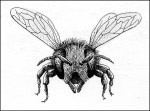
In the wooden storage boxes of the University of Vermont’s insect collection, there are plenty of examples of a native bumblebee species (Bombus affinis) that has a black head, broad yellow stripes, and no common name. Generations of net-wielding undergrads added fresh specimens to the university’s collection up until the 1990s.
Since 1999, however, and in spite of searching across fields and through forests, Leif Richardson, a Vermont-based bumblebee researcher, hasn’t seen a single member of that species. He knows of four other once-common Vermont bumblebee species that have all but disappeared from the state as well.
Bumblebees and honeybees have both experienced sharp declines recently. News reports of late have focused on Colony Collapse Disorder (CCD), a mysterious syndrome that has killed off as many as 90 percent of the honeybees in some beekeepers’ hives in 35 states, including New Hampshire but not Vermont.
But honeybees were in trouble long before CCD struck, and so were native bees, including many bumblebee species, for a variety of reasons.
Just to be clear, honeybees are not native to North America. They are, however, what most likely comes to mind when someone says “bee.” There is just one species that answers to the name honeybee in North America: they live in large hives and produce honey; these days most honeybees are raised primarily to pollinate crops.
There are about 4,000 species of native bees in North America, says Stephen Buchmann, international coordinator for the North American Pollinator Protection Campaign and co-author of the book, The Forgotten Pollinators.
Of those native bee species, bumblebees are perhaps the most like honeybees, which may be one reason why the two are sometimes confused. Most bumblebees are bigger than honeybees, and fatter. Both kinds of bees are fuzzy and buzzy.
But bumblebees nest in small colonies in the ground, often in abandoned mouse or vole holes. They make some honey - just enough for a rainy day - but do not need a large surplus because their colonies don’t overwinter like honeybees’ do.
Richardson, whose day job is as the state lands ecologist at the Vermont Fish and Wildlife’s Nongame and Natural Heritage Program, says there are about 20 species of bumblebees in Vermont. According to the University of New Hampshire insect collection’s checklist, there are 16 species in New Hampshire.
Bombus fervidus - another bumblebee species (so few have common names) - is also common in the UVM collection, says Richardson. New specimens stopped being added to the collection in the 1990s. “I’ve looked hard for it, and have rarely seen it,” he says. He has spoken to researchers in the Midwest, who have had little luck finding it either.
Bumblebees are not just disappearing from Vermont and New Hampshire. It’s a continent-wide phenomenon. Franklin’s bumblebee, rare for having a common name as well has for existing only in a small area in northern California and southern Oregon, is believed to have recently gone extinct. It’s one of five bumblebee species, including B. affinis, that the Xerces Society for Invertebrate Conservation has singled out for having a population in steep decline.
No one knows exactly what is happening to bumblebees, but most experts are convinced that loss of habitat, use of pesticides, and the introduction of non-native parasites are all playing important roles in the decline.
Habitat loss can be extreme, such as when a pasture becomes a shopping center, or it can be subtle. Richardson says Bombus pensylvanicus requires large grasslands as habitat, and it nests in New Hampshire and Vermont on the ground in hayfields. It was once common, he says, but he’s only seen the species once himself. He suspects that intensifying agriculture - dairy farmers now cut hay from a single field as often as three times a year - has led to its decline.
In some instances, bumblebees are employed to pollinate greenhouse tomatoes, since honeybees are incapable of that job. As these bumblebees are commercially raised and sold around the world, they pick up parasites, such as mites, that can weaken or kill them. When infected bumblebees escape to the wild, they bring those parasites to native populations.
The good news is that scientists like Richardson are studying the problem at the local level, giving policy-makers the information that they badly need.
The situation is starting to receive some national attention as well, says Matthew Shepherd, Pollinator Conservation Program Director for the Xerces Society in Portland, Oregon. Last autumn, the National Academies of Science released a report describing the dire state of pollinators in the United States, including bumblebees. The report concluded that more research is needed. Congress is now discussing funding for that research, says Shepherd.
The U.S. Postal Service celebrated National Pollinator Week on June 24-30 by releasing a block of stamps depicting native pollinators and wildflowers. One of the four stamps shows the flower of a purple nightshade being pollinated by a bumblebee.

